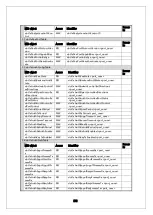
279
Troubleshooting
If you find any problem, please take the following steps to check.
1. LED indicators
* The POWER LED is not lit.
- Is the power cord connected?
Please confirm that the power cord is securely connected to the power
port.
* The port LED (left) is not lit in Status mode.
- Is the Switching Hub set to Status mode?
If the Switching Hub is set to the ECO mode, all LEDs are turned off
regardless of terminal connection state.
- Is the cable correctly connected to the target port?
- Is the cable appropriate to use?
- Is each terminal connected to the relevant port conforming with
10BASE-T, 100BASE-TX, or 1000BASE-T standard?
- Auto-negotiation may have failed.
Set the port of this Switching Hub or the terminal to half-duplex mode.
* The port LED (right) lights in orange.
- A loop has occurred. By removing the loop, orange LED will be turned off.
* LOOP HISTORY LED blinks in orange.
- This is to notify that there is a port in which a loop is occurring, or has been
removed within 3 days.
2. Communications are slow.
* Communications with all ports are impossible or slow.
- Are the communication speed and mode settings correct?
If the communication mode signal cannot be properly obtained, apply
half-duplex mode.
Switch the communication mode of the connection target to
half-duplex mode.
Do not fix the communication mode of the connected terminal to
full-duplex mode.
- Is the link up?
If the power saving mode is set to "Full," change it to "Half" or "Disabled."
- Is not the utilization ratio of the network to which this Switching Hub is
connected too high?
Try separating this Switching Hub from the network.
- Doesn't the port LED (right) light in orange?
When the port LED (right) lights in orange, the port has been shut down
by loop detection function. After removing the loop under this port,
wait for the auto-recovery time set in loop detection function, or
unblock the port on the configuration screen.



































